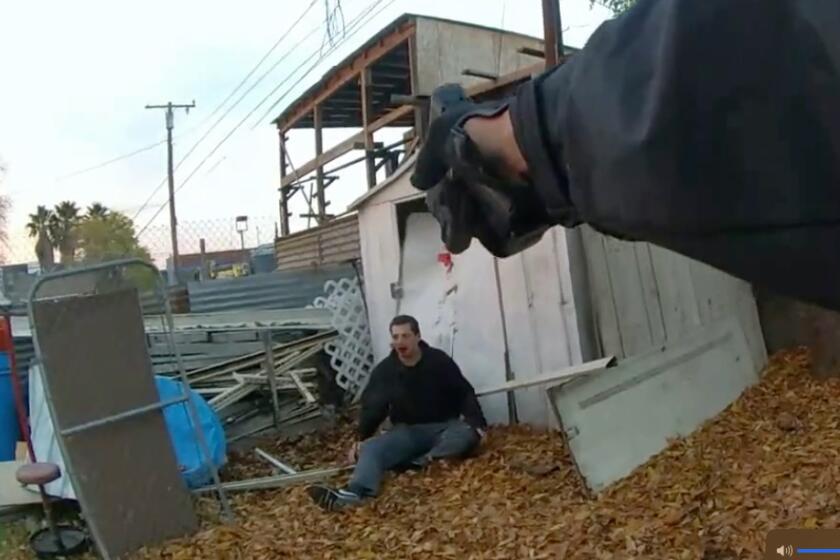Los Angeles Fire Department tries out a motorcycle response unit
- Share via
Los Angeles firefighter Greg Pascola spotted a column of smoke from the corner of his eye — a fire burning on a distant hillside.
He looked east from his vantage point on a mountaintop road near Mulholland Drive and felt wind at his back. It was 3 p.m. on a September Friday that would see record-breaking heat, and cars choked every lane of the 405 Freeway for miles.
He and his partner gunned their motorcycles.
They are part of the Los Angeles Fire Department’s pilot motorcycle response team, a five-man unit that can speed to the side of an injured victim, provide information to dispatchers and skirt traffic to scout fires and other problems. The unit first rode during last year’s “Carmageddon” closure of the 405, and its next deployment will take place during the follow-up closure this weekend, when workers will demolish the other half of the Mulholland Drive bridge overhead.
Fire departments serving traffic-snarled cities around the nation have adopted similar motorcycle teams to improve response times, staff special events and, in some cases, save lives and resources. As the L.A. department faces budget cuts and intense scrutiny over response times that lag behind national standards, some believe that a roving motorcycle unit could help the department.
The pilot unit features five off-road-capable motorcycles on loan from the Kawasaki Motor Corp. Each bike retails for about $6,300 and is outfitted with a defibrillator, a small fire extinguisher, various medical supplies and a handlebar-mounted GPS system. A dozen firefighters have undergone the necessary training, and a permanent unit could have up to 10 motorcycles and 28 riders, said Capt. Craig White, who first proposed the unit to the department.
White said he’d thought about creating a motorcycle unit for years, and last year’s 405 closure — shutting down 10 miles of one of the nation’s busiest freeways — presented the ideal test. The department already had a bicycle medic unit for events such as the L.A. Marathon.
Though the nightmare Carmageddon traffic jams that officials feared never materialized, the motorcycle unit had an opportunity to show what it could do earlier this month.
As a 70-acre brush fire stopped traffic on the 405 and caused the evacuation of the Getty Center, Pascola and his partner reached the command post within three minutes — even before helicopters could reach the site. They were handed radios and began to map the blaze, weaving between cars, hopping sidewalks and navigating narrow, curving mountain roads.
“At the time, we were the only ones out there to scout,” Pascola said.
In addition to scouting fires, advocates say the motorcycle response team could also help save lives. When a heart attack occurs, the American Heart and Lung Assn. says, irreversible brain damage can begin after four minutes. Motorcycle-borne medics equipped with defibrillators in Miami cut response times from an average of seven minutes to less than three in some places, said Capt. Roman Bas of Miami-Dade Fire Rescue.
“Absolutely it saved lives,” Bas said. “And it saved money too.”
Bas said deploying motorcycles instead of ambulances and trucks reduced fuel consumption and extended the working life of more valuable emergency response vehicles, which were used less. He had planned to expand the program to 12 battalions, with a roving motorcycle response unit to cover multiple areas of the city.
But Miami’s motorcycle medic unit was dismantled in 2008 after departmentwide budget cuts. Though the program was relatively cheap — the fleet of 10 donated motorcycles cost $36,000 a year to maintain — Bas said it wasn’t a priority.
“Putting firefighters on motorcycles is just not tradition,” Bas said. “You still have departments where all they do is handle fire. They need to look into new ways of using these units.”
The Seattle Fire Department has also explored motorcycle response units, but a program never got off the ground. Austin, Texas, has a program with four motorcycles, but it is run separately from the Austin Fire Department.
The units are more common overseas in Japan and Europe, where some motorcycle units tow cars and fight fires with specialized attachments.
White said LAFD officials want to see if state and federal grants could help make their motorcycle unit permanent, although a large expansion like the one Miami’s Bas had wanted is unlikely.
LAFD Chief Brian Cummings said motorcycles could be “one of the solutions” the department considers for improving response times.
“Do I see the motorcycles supplanting larger vehicles? No. There’s always going to be a need to bring heavy equipment and large numbers of individuals,” Cummings said. “They each have a role. They’re each tools in the toolbox.”
White, a motorcycle enthusiast since high school, said the unit’s biggest selling point is its flexibility.
“Right now,” he said, “we just want to see what we can do with them.”
More to Read
Sign up for Essential California
The most important California stories and recommendations in your inbox every morning.
You may occasionally receive promotional content from the Los Angeles Times.











